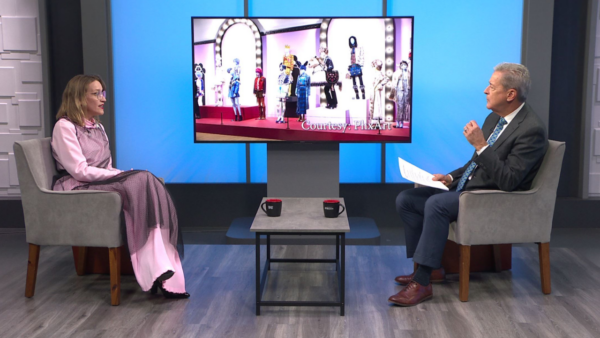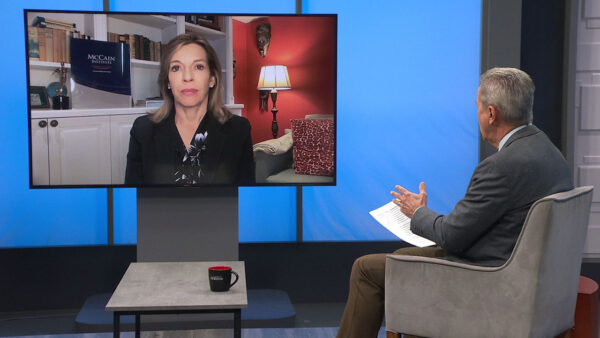The Arizona Department of Transportation has begun a three-year environmental study to select possible routes for Interstate 11 between Nogales and Wickenburg and is seeking public input. ADOT project manager Michael Kies (Keys) will tell us more.
Ted Simons: Coming up next on "Arizona Horizon," the latest on Arizona portions of a planned freeway from Mexico to Las Vegas. Also tonight, we'll discuss voter turnout and the upcoming Arizona primary. And we'll learn about a new safety campaign underway on Phoenix hiking trails. That's next on "Arizona Horizon."
Video: "Arizona Horizon" is made possible by contributions from the Friends of Arizona PBS, members of your PBS station. Thank you.
Ted Simons: Good evening and welcome to "Arizona Horizon," I'm Ted Simons. Senate president Andy Biggs is blocking a bill that would restore health insurance coverage to children in low-income families. The bill to restore KidsCare passed the House last week, but has yet to move in the senate and likely won't be heard due to Biggs' opposition to the KidsCare. Arizona is the only state in the country that does not have an active version of the children's health insurance program. The State Department of Transportation is in the process of hearing public input on the selection of possible routes for Interstate 11, between Nogales and Wickenburg. Joining us now is ADOT project manager Michael Kies. Good to see you again, thanks for joining us. Now, I'm a little confused here. There was a study, there is a study? These studies piggyback? What's going on out there?
Michael Kies: All right, I'm glad you asked. We did start a previous study looking at the concept of a new transportation corridor between Arizona and Nevada and that was a two-year study that we partnered with the Nevada Department of Transportation. We called that a feasibility study and the results of that was we determined there's justification to look at a new Interstate highway here in Arizona called Interstate 11. Now, we're doing a follow-up study that's looking more specifically at where this highway might be located between Wickenburg and Nogales, Arizona, and we call that an Environmental Impact Statement.
Ted Simons: And the Environmental Impact Statement asks for public input, correct?
Michael Kies: Yes, yes. In fact, public input is a cornerstone of the environmental process.
Ted Simons: For the feasibility study, it sounds like it could be, should be, might be a go. How many different options are you talking about? Nogales to Wickenburg? You can go every which way here, can't you?
Michael Kies: We could yeah. What we did with the feasibility study is we looked at a very high level at all the different connections we could make in Arizona and Nevada. So examples might be would a corridor like this connect to Yuma or to Douglas or to Nogales? And we settled on a general corridor from Wickenburg around Phoenix through the Tucson area to Nogales. And we have a corridor that's five to 50 miles wide, depending on where you are. And now, we're going to look at all the possible options for a corridor alignment within that area.
Ted Simons: Does it make sense for a new I-11 to be anywhere near I-10?
Michael Kies: Yes in some cases there's parts of I-10, you may know, that when traffic is interrupted by an incident or there's a closure of Interstate 10, there are no good alternate routes for people to take. So having a parallel facility in the area could be helpful to the public.
Ted Simons: Now, this is not just for vehicle traffic, correct? This is for rail traffic as well?
Michael Kies: Well, that's all under consideration. We're calling it a multiuse corridor now and the Environmental Impact Statement will be done in two parts. The first is an alternative selection process and that's where we ask the question what should the corridor look like from a mode standpoint? Should it include rail or should it just be a highway or should it be a combination of both and where might it be located? And then we'll narrow that down and once we have a few recommended alternatives, we'll do an environmental analysis of those.
Ted Simons: And when those few recommended alternatives come through, folks are saying I want it to go over there, not here?
Michael Kies: That's the public input process, we ask the public to give us any input that they feel is appropriate for us to make a decision about this future transportation corridor. We have a website that's set up. We have an e-mail address where people can e-mail us directly their thoughts. Later this summer we'll be doing public meetings where we actually hold it in locations that the public can come to and see maps and ask staff questions about it. And throughout the whole process, they can provide input that they feel is relevant to us.
Ted Simons: Aren't parts of I-11 in Nevada already under construction?
Michael Kies: I'm glad you asked. There is a section of Interstate 11 that's under construction in Nevada called the Boulder City By-pass and so there's a community just beyond the Hoover Dam that's called Boulder City and Nevada is building a new freeway around that community that's going to connect to the new bridge at Hoover Dam and be the first section of Interstate 11 open to traffic.
Ted Simons: And again, when you get the public input with the Environmental Impact Study which follows the feasibility study, after all the studies are done, just give me a ballpark figure. When will the rubber hit the road?
Michael Kies: Well, that's very difficult to answer because I hate to complicate things but this tier one EIS is one step of the study process. There will be more follow-up studies after this study. What this study is looking to do is to establish a recommended core. Then we need to do further studies that got down to the right of way levels.
Ted Simons: If it goes at this certain pace, it could be 10 to 15 years but if it goes at a pace in which all of a sudden, you have lurches forward, maybe quicker than expected, it could be eight to 20 years, who knows?
Michael Kies: That's exactly right. And that's why we're getting a jump start on the planning so that we can get a lot of this planning underway and make some decisions so if the economy starts to get very hot in the future and freight traffic grows at an unexpected rate, we could be ready to start implementing maybe pieces of this corridor.
Ted Simons: Environmental Impact Study costs the state what? How much?
Michael Kies: Right now, we are estimating it at $15 million and it will last about three years.
Ted Simons: And this again, I want to make sure people aren't confused. Is this the same thing, I-11 now, from Nogales up to Vegas and perhaps beyond, is this the same thing as what is perceived as a Vegas to Mexico City International Commerce Corridor?
Michael Kies: It is yes. This idea of better transportation connection from Mexico which, of course, there's a corridor that goes all the way to Mexico City, north to Las Vegas, and then through the intermountain west, has been around for decades and the Interstate 11 concept is now just taking that original concept which was called the Cana-Mex corridor that went from Canada to Mexico and now, we're framing it in more detail and moving it forward.
Ted Simons: Very good, thanks for joining us. We appreciate it.
Michael Kies: Thank you.
Video: Get the inside scoop on what's happening at Arizona PBS. Become an insider. You'll receive weekly updates on the most anticipated upcoming programs and events. Get the insider delivered to your e-mail inbox. Visit azpbs.org to sign up today.
Michael Kies: ADOT project manager























